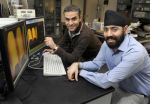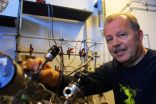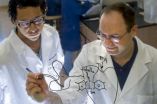(Press-News.org) AMES, Iowa – Researchers from Iowa State University and the Ames Laboratory have developed a process capable of producing a thin and uniform light-absorbing layer on textured substrates that improves the efficiency of polymer solar cells by increasing light absorption.
"Our technology efficiently utilizes the light trapping scheme," said Sumit Chaudhary, an Iowa State assistant professor of electrical and computer engineering and an associate of the U.S. Department of Energy's Ames Laboratory. "And so solar cell efficiency improved by 20 percent."
Details of the fabrication technology were recently published online by the journal Advanced Materials: http://onlinelibrary.wiley.com/doi/10.1002/adma.201002898/abstract;jsessionid=D83B2095A0572345BF38B850977F0568.d03t01
Chaudhary said the key to improving the performance of solar cells made from flexible, lightweight and easy-to-manufacture polymers was to find a textured substrate pattern that allowed deposition of a light-absorbing layer that's uniformly thin – even as it goes up and down flat-topped ridges that are less than a millionth of a meter high.
The result is a polymer solar cell that captures more light within those ridges – including light that's reflected from one ridge to another, he said. The cell is also able to maintain the good electrical transport properties of a thin, uniform light-absorbing layer.
Tests indicated the research team's light-trapping cells increased power conversion efficiency by 20 percent over flat solar cells made from polymers, Chaudhary said. Tests also indicated that light captured at the red/near infrared band edge increased by 100 percent over flat cells.
Researchers working with Chaudhary on the solar cell project are Kai-Ming Ho, an Iowa State Distinguished Professor of Physics and Astronomy and an Ames Laboratory faculty scientist; Joong-Mok Park, an assistant scientist with the Ames Laboratory; and Kanwar Singh Nalwa, a graduate student in electrical and computer engineering and a student associate of the Ames Laboratory. The research was supported by the Iowa Power Fund, the Ames Laboratory and the Department of Energy's Office of Basic Energy Sciences.
The idea of boosting the performance of polymer solar cells by using a textured substrate is not a new one, Chaudhary said. The technology is commonly used in traditional, silicon-based solar cells.
But previous attempts to use textured substrates in polymer solar cells have failed because they require extra processing steps or technically challenging coating technologies. Some attempts produced a light-absorbing layer with air gaps or a too-thin layer over the ridges or a too-thick layer over the valleys. The result was a loss of charges and short circuiting at the valleys and ridges, resulting in poor solar cell performance.
But, get the substrate texture and the solution-based coating just right, "and we're getting more power out," Nalwa said.
The Iowa State University Research Foundation Inc. has filed a patent for the substrate and coating technology and is working to license the technology to solar cell manufacturers.
"This may be an old idea we're using," Chaudhary said, "but it's never before been successfully implemented in polymer solar cells."
INFORMATION:
Iowa State, Ames Lab researchers fabricate more efficient polymer solar cells
2010-12-04
ELSE PRESS RELEASES FROM THIS DATE:
UCSB scientists report study of 'brain maps' for how humans reach
2010-12-04
(Santa Barbara, Calif.) –– A ballet dancer grasps her partner's hand to connect for a pas de deux. Later that night, in the dark, she reaches for her calf to massage a sore spot. Her brain is using different "maps" to plan for each of these movements, according to a new study at UC Santa Barbara.
In preparing for each of these reaching movements, the same part of the dancer's brain is activated, but it uses a different map to specify the action, according to the research. Planning to hold hands is based on her visual map of space. Her second plan, to reach for her calf, ...
Researchers discover a way to simultaneously desalinate water, produce hydrogen and treat wastewater
2010-12-04
DENVER (December 2, 2010) – Fresh water and reusable energy. Humans are on a constant hunt for a sustainable supply of both. Water purification requires a lot of energy, while utility companies need large amounts of water for energy production. Their goal is to find a low-energy-required treatment technology. Researchers from the University of Colorado Denver College of Engineering and Applied Science may have discovered an answer.
Last year, a study published in Environmental Science & Technology incorporated desalination into microbial fuel cells, a new technology ...
Spanish Oncology to establish a new standard treatment on breast cancer at early stages
2010-12-04
Madrid, 2 december 2010.- Spanish Oncology has established a new standard treatment for Breast Cancer at early stages thanks to the results of the study 9805/Target 0 funded by Spanish Breast Cancer Research Group (GEICAM) and sponsored by Sanofi Aventis.
More than thousand patients and 50 hospitals participated in the study, whose findings are reported in the latest issue of The New England Journal of Medicine. Results indicate that docentaxel during quimotherapy reduces the risk of recurrence by 32% in women with high-risk but node-negative, early stage breast cancer ...
Farmers slowed down by hunter-gatherers: Our ancestors' fight for space
2010-12-04
Agricultural – or Neolithic – economics replaced the Mesolithic social model of hunter-gathering in the Near East about 10,000 years ago. One of the most important socioeconomic changes in human history, this socioeconomic shift, known as the Neolithic transition, spread gradually across Europe until it slowed down when more northern latitudes were reached.
Research published today, Friday, 3 December 2010, in New Journal of Physics (co-owned by the Institute of Physics and the German Physical Society), details a physical model, which can potentially explain how the spreading ...
Decreased physician reimbursement for hormone therapy may reduce over-treatment of prostate cancer
2010-12-04
The use of androgen suppression therapy (AST) in prostate cancer for low-risk cases declined following a decrease in physician reimbursement, according to a study published online TK in The Journal of the National Cancer Institute. However, the indicated use of AST for metastatic disease in the palliative setting did not decline in the same period.
The use of AST in prostate cancer increased more than threefold between 1991 and 1999 both for patients with metastatic cancer and those with low-risk disease, but AST treatment in the latter group has not been shown to improve ...
Assessing positive outcomes of phase III trials
2010-12-04
Randomized phase III studies should be designed to find out whether a new drug or treatment makes a meaningful difference in patients' survival or quality of life, according to a commentary published online December 3rd in The Journal of the National Cancer Institute. Instead, most trials now are designed to detect a statistically significant difference between treatment and control groups, which may not be clinically meaningful, write Alberto Ocana, M.D., Ph.D. and Ian F. Tannock, M.D., Ph.D., of Princess Margaret Hospital in Toronto.
Regulatory agencies such as the ...
Improvement needed for mastectomy outcome reporting
2010-12-04
Improved standards for outcome reporting in breast reconstruction are needed, according to a review published online December 3rd in The Journal of the National Cancer Institute.
Every year in the United States up to 40% of women with breast cancer undergo a mastectomy. They say the most valuable factor in their decision-making is information from health professionals. However, that information is largely dependent on the quality, reporting, and interpretation of research data on surgical procedures.
To summarize the reporting standards of surgical outcomes in breast ...
Breast CT imaging system marches forward as pain-free tool to aid mammograms
2010-12-04
While questions persist about the best ways to detect breast cancer early, a CT imaging system developed at the University of Rochester Medical Center and first unveiled five years ago is in a better position today to enter the fray -- at least in a supporting role to conventional mammography.
URMC radiologist Avice O'Connell, M.D., was invited to summarize the studies conducted thus far on the Cone Beam Computed Tomography (CBCT) scanner, at the Radiological Society of North America Annual Scientific Assembly in Chicago at 8:30 a.m. (EST) on Friday, December 3, 2010.
O'Connell ...
Anesthetic gases heats climate as much as 1 million cars
2010-12-04
When doctors want their patients asleep during surgery they gently turn the gas tap. But Anaesthetic gasses have a global warming potential as high as a refrigerant that is on its way to being banned in the EU. Yet there is no obligation to report anaesthetic gasses along with other greenhouse gasses such as CO2, refrigerants and laughing gas.
One kilo of anaesthetic gas affects the climate as much as 1620 kilos of CO2. That has been shown by a recent study carried out by chemists from University of Copenhagen and NASA in collaboration with anaesthesiologists from the ...
Dynamics of chaperone protein critical in rescuing brains of Alzheimer's mice from neuron damage
2010-12-04
Tampa, FL (Dec. 3, 2010) -- Dynamic regulation of the chaperone protein Hsp27 was required to get rid of abnormally accumulating tau in the brains of mice genetically modified to develop the memory-choking tau tangles associated with Alzheimer's disease, a University of South Florida-led study found.
Researchers at the USF Health Byrd Alzheimer's Institute demonstrated that the effective switching of Hsp27 between its active and deactivated states was critical on two fronts -- to promote the recycling of the tau protein in healthy nerve cells and to clear abnormal tau ...


